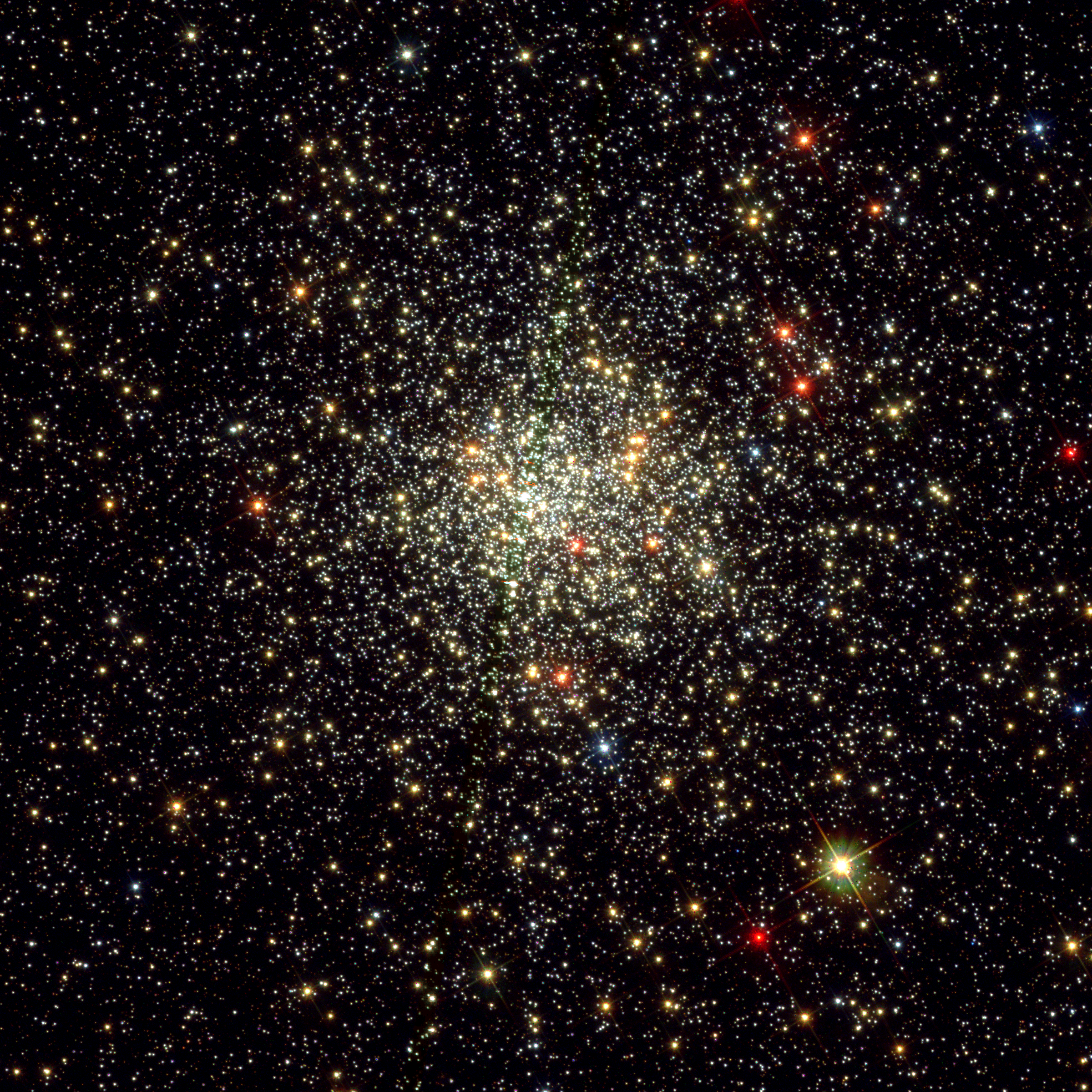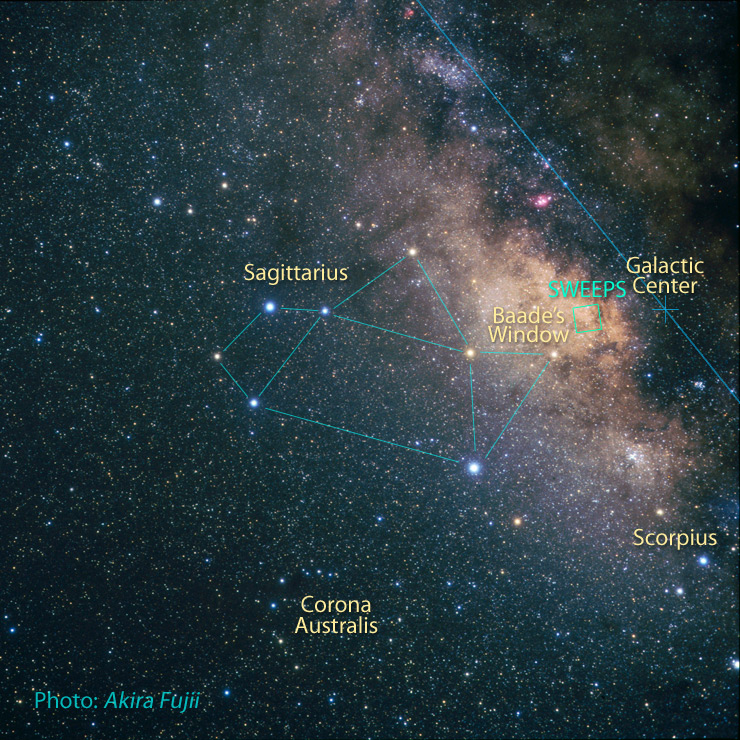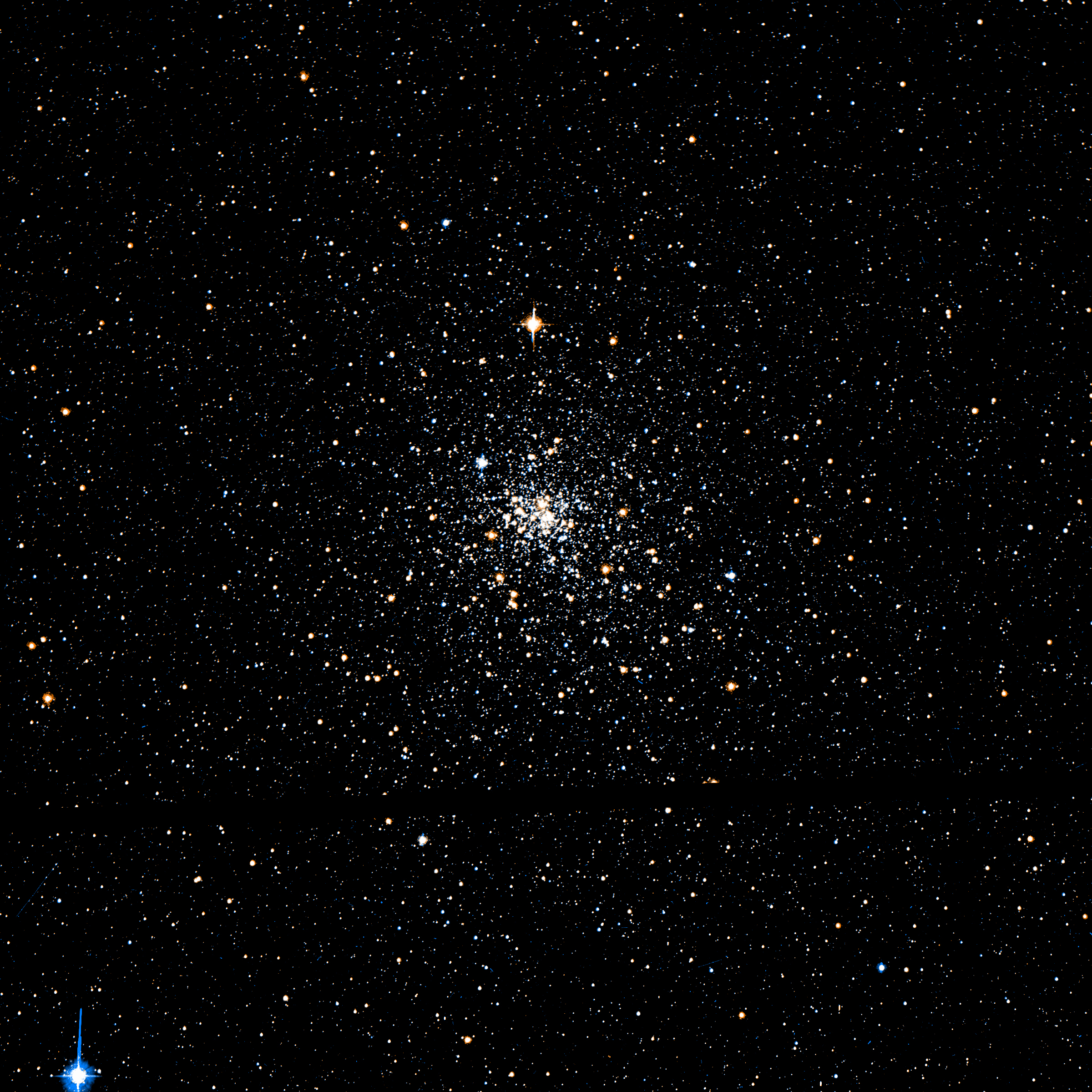|
NGC 6528
NGC 6528 is a globular cluster in the constellation Sagittarius, and is listed in the New General Catalogue. It has an apparent magnitude of about 11 and a diameter of about 16 arcminutes, and its Shapley-Sawyer Concentration Class is V, containing stars of 16th magnitude and dimmer. Dreyer described it as "pF, cS, R", meaning poor and faint, considerably small and round. NGC 6528 is located southwest of NGC 6522, another globular cluster. Both are located in Baade's Window, a relatively clear area near the galactic equator. The globular cluster was discovered in 1784 by the astronomer William Herschel with his 18-inch telescopes. The NGC 6528 is unusually metal-rich for a globular cluster, and is very similar in composition to NGC 6553, suggesting an origin in a similar environment. References * Robert Burnham, Jr Robert Burnham Jr. (June 16, 1931 – March 20, 1993) was an American astronomer, best known for writing the classic three-volume ''Burnham's Celestial Hand ... [...More Info...] [...Related Items...] OR: [Wikipedia] [Google] [Baidu] |
NGC 6528 Hst 11664 51 R814G555B390 9453 62 R814G606B
NGC commonly refers to: * New General Catalogue of Nebulae and Clusters of Stars, a catalogue of deep sky objects in astronomy NGC may also refer to: Companies * NGC Corporation, name of US electric company Dynegy, Inc. from 1995 to 1998 * National Gas Company of Trinidad and Tobago, state-owned natural gas company in Trinidad and Tobago * National Grid plc, a former name of National Grid Electricity Transmission plc, the operator of the British electricity transmission system * Northrop Grumman Corporation, aerospace and defense conglomerate formed from the merger of Northrop Corporation and Grumman Corporation in 1994 * Numismatic Guaranty Corporation, coin certification company in the United States Other uses * National Gallery of Canada, art gallery founded in 1880 in Ottawa, Canada * National Geographic, documentary and reality television channel established in the United States in 2001 formerly called National Geographic Channel * Native Girls Code, US non-profit organisat ... [...More Info...] [...Related Items...] OR: [Wikipedia] [Google] [Baidu] |
Robert Burnham, Jr
Robert Burnham Jr. (June 16, 1931 – March 20, 1993) was an American astronomer, best known for writing the classic three-volume ''Burnham's Celestial Handbook''. He is the discoverer of numerous asteroids including the Mars crossing asteroid 3397 Leyla, as well as six comets. Burnham's late years were tragic; he died destitute and alone. However, he is remembered by a generation of deep sky observers for his unique contribution to astronomy, the ''Celestial Handbook.'' The main-belt asteroid 3467 Bernheim was named in his honor. Early life and career Burnham was born in Chicago, Illinois, in 1931, the son of Robert Sr. and Lydia. His family moved to Prescott, Arizona, in 1940, and he graduated from high school there in 1949. That was the culmination of his formal education. Always a shy person, he had few friends, never married, and spent most of his time observing with his home-built telescope. In the fall of 1957 he received considerable local publicity ... [...More Info...] [...Related Items...] OR: [Wikipedia] [Google] [Baidu] |
N6522 32ins , a camera
{{Letter-NumberCombDisambig ...
N65 may refer to: Roads * N65 highway (Philippines) * N65 road (Ireland) * Nebraska Highway 65, in the United States Other uses * N65 (Long Island bus) * Escadrille N65, a unit of the French Air Force * , a S-class submarine of the Royal Navy sunk in 1940 * , a U-class submarine of the Royal Navy sunk in 1941 * London Buses route N65 * Nikon N65 (, ; ), also known just as Nikon, is a Japanese multinational corporation headquartered in Tokyo, Japan, specializing in optics and Photography, imaging products. The companies held by Nikon form the Nikon Group. Nikon's products include cam ... [...More Info...] [...Related Items...] OR: [Wikipedia] [Google] [Baidu] |
NGC 6553
NGC 6553 is a globular cluster in the constellation Sagittarius. NGC 6553 has an apparent magnitude of about 8th magnitude with an apparent diameter of 8.2 arcminutes. Its Shapley–Sawyer Concentration Class is XI, meaning the star concentration is very loose even at the center; it has stars of magnitude 20 and dimmer. It is located just over a degree southeast of Messier 8, the Lagoon Nebula. Unlike common globular clusters, NGC 6553 is relatively metal-rich, and there is evidence of at least two periods of star formation. Due to a complex star-forming record, the stars in the cluster are differing in composition, most notably in concentrations of sodium and aluminium. NGC 6553 is very similar in composition to NGC 6528 NGC 6528 is a globular cluster in the constellation Sagittarius, and is listed in the New General Catalogue. It has an apparent magnitude of about 11 and a diameter of about 16 arcminutes, and its Shapley-Sawyer Concentration Class is V, contain ..., sugges ... [...More Info...] [...Related Items...] OR: [Wikipedia] [Google] [Baidu] |
Telescope
A telescope is a device used to observe distant objects by their emission, absorption, or reflection of electromagnetic radiation. Originally meaning only an optical instrument using lenses, curved mirrors, or a combination of both to observe distant objects, the word ''telescope'' now refers to a wide range of instruments capable of detecting different regions of the electromagnetic spectrum, and in some cases other types of detectors. The first known practical telescopes were refracting telescopes with glass lenses and were invented in the Netherlands at the beginning of the 17th century. They were used for both terrestrial applications and astronomy. The reflecting telescope, which uses mirrors to collect and focus light, was invented within a few decades of the first refracting telescope. In the 20th century, many new types of telescopes were invented, including radio telescopes in the 1930s and infrared telescopes in the 1960s. Etymology The word ''telescope'' was coin ... [...More Info...] [...Related Items...] OR: [Wikipedia] [Google] [Baidu] |
William Herschel
Frederick William Herschel (; german: Friedrich Wilhelm Herschel; 15 November 1738 – 25 August 1822) was a German-born British astronomer and composer. He frequently collaborated with his younger sister and fellow astronomer Caroline Herschel (1750–1848). Born in the Electorate of Hanover, William Herschel followed his father into the military band of Hanover, before emigrating to Great Britain in 1757 at the age of nineteen. Herschel constructed his first large telescope in 1774, after which he spent nine years carrying out sky surveys to investigate double stars. Herschel published catalogues of nebulae in 1802 (2,500 objects) and in 1820 (5,000 objects). The resolving power of the Herschel telescopes revealed that many objects called nebulae in the Messier catalogue were actually clusters of stars. On 13 March 1781 while making observations he made note of a new object in the constellation of Gemini. This would, after several weeks of verification and consultation ... [...More Info...] [...Related Items...] OR: [Wikipedia] [Google] [Baidu] |
Baade's Window
Baade's Window is an area of the sky with relatively low amounts of cosmic dust, interstellar dust along the line of sight from Earth. This area is considered an observational "window" as the normally obscured Galactic Center of the Milky Way is visible in this direction. It is named for astronomer Walter Baade, who first recognized its significance. This area corresponds to one of the brightest visible patches of the Milky Way. It is centered at a Galactic coordinate system#Galactic longitude, galactic longitude (') of 1.02° and a Galactic coordinate system#Galactic latitude, galactic latitude (') of -3.92°, which corresponds to a right ascension of 18h 03m 32.14s and a declination of -30d 02m 06.96s, in the direction of the constellation Sagittarius (constellation), Sagittarius. History Walter Baade observed the stars in this area in the mid-1940s using the Hooker telescope at Mount Wilson Observatory in California while searching for the center of the Milky Way galaxy. Up un ... [...More Info...] [...Related Items...] OR: [Wikipedia] [Google] [Baidu] |
NGC 6522
NGC 6522 is a globular cluster in the constellation Sagittarius. It is apparent magnitude 8.3, and diameter 16.4 arc minutes, and class VI with stars 16th magnitude and dimmer. It was discovered by William Herschel on June 24, 1784. It is centered in a region of the sky known as Baade's Window. NGC 6522 is possibly the oldest star cluster in the Milky Way, with an age of more than 12 billion years. '''' by David Shiga, 30 April 2011, p. 20 [...More Info...] [...Related Items...] OR: [Wikipedia] [Google] [Baidu] |
Apparent Magnitude
Apparent magnitude () is a measure of the brightness of a star or other astronomical object observed from Earth. An object's apparent magnitude depends on its intrinsic luminosity, its distance from Earth, and any extinction of the object's light caused by interstellar dust along the line of sight to the observer. The word ''magnitude'' in astronomy, unless stated otherwise, usually refers to a celestial object's apparent magnitude. The magnitude scale dates back to the ancient Roman astronomer Claudius Ptolemy, whose star catalog listed stars from 1st magnitude (brightest) to 6th magnitude (dimmest). The modern scale was mathematically defined in a way to closely match this historical system. The scale is reverse logarithmic: the brighter an object is, the lower its magnitude number. A difference of 1.0 in magnitude corresponds to a brightness ratio of \sqrt /math>, or about 2.512. For example, a star of magnitude 2.0 is 2.512 times as bright as a star of magnitude 3.0, 6. ... [...More Info...] [...Related Items...] OR: [Wikipedia] [Google] [Baidu] |
Hubble Space Telescope
The Hubble Space Telescope (often referred to as HST or Hubble) is a space telescope that was launched into low Earth orbit in 1990 and remains in operation. It was not the first space telescope, but it is one of the largest and most versatile, renowned both as a vital research tool and as a public relations boon for astronomy. The Hubble telescope is named after astronomer Edwin Hubble and is one of NASA's Great Observatories. The Space Telescope Science Institute (STScI) selects Hubble's targets and processes the resulting data, while the Goddard Space Flight Center (GSFC) controls the spacecraft. Hubble features a mirror, and its five main instruments observe in the ultraviolet, visible, and near-infrared regions of the electromagnetic spectrum. Hubble's orbit outside the distortion of Earth's atmosphere allows it to capture extremely high-resolution images with substantially lower background light than ground-based telescopes. It has recorded some of the most detaile ... [...More Info...] [...Related Items...] OR: [Wikipedia] [Google] [Baidu] |
New General Catalogue
The ''New General Catalogue of Nebulae and Clusters of Stars'' (abbreviated NGC) is an astronomical catalogue of deep-sky objects compiled by John Louis Emil Dreyer in 1888. The NGC contains 7,840 objects, including galaxies, star clusters and emission nebulae. Dreyer published two supplements to the NGC in 1895 and 1908, known as the ''Index Catalogues'' (abbreviated IC), describing a further 5,386 astronomical objects. Thousands of these objects are best known by their NGC or IC numbers, which remain in widespread use. The NGC expanded and consolidated the cataloguing work of William and Caroline Herschel, and John Herschel's ''General Catalogue of Nebulae and Clusters of Stars''. Objects south of the celestial equator are catalogued somewhat less thoroughly, but many were included based on observation by John Herschel or James Dunlop. The NGC contained multiple errors, but attempts to eliminate them were made by the ''Revised New General Catalogue'' (RNGC) by Jack W. Sulent ... [...More Info...] [...Related Items...] OR: [Wikipedia] [Google] [Baidu] |









